Related Research Articles
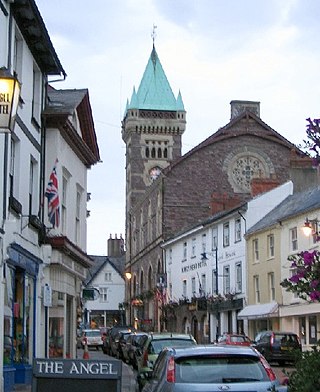
Abergavenny (; Welsh: Y Fennipronounced[əˈvɛnɪ], archaically Abergafenni is a market town and community in Monmouthshire, Wales. Abergavenny is promoted as a "Gateway to Wales"; it is approximately 6 miles from the border with England and is located where the A40 trunk road and the recently upgraded A465 Heads of the Valleys road meet.

Owain ap Gruffydd, commonly known as Owain Glyndŵr was a Welsh leader, soldier and military commander in the late Middle Ages, who led a 15-year-long Welsh revolt with the aim of ending English rule in Wales. He was an educated lawyer, forming the first Welsh parliament under his rule, and was the last native-born Welshman to claim the title Prince of Wales.

Llywelyn ap Gruffudd, Llywelyn II, also known as Llywelyn the Last, was Prince of Gwynedd, and later was recognised as the Prince of Wales from 1258 until his death at Cilmeri in 1282. Llywelyn was the son of Gruffudd ap Llywelyn ap Iorwerth and grandson of Llywelyn ab Iorwerth, and he was one of the last native and independent princes of Wales before its conquest by Edward I of England and English rule in Wales that followed, until Owain Glyndŵr held the title during the Welsh Revolt of 1400–1415.

Skirrid Fawr, often referred to as just the Skirrid, is an easterly outlier of the Black Mountains in Wales. It forms the easternmost part of the Brecon Beacons National Park. The smaller hill of Ysgyryd Fach or "Little Skirrid" lies about 2+1⁄2 miles south.

Trellech is a village and parish in Monmouthshire, south-east Wales. Located 5 miles (8 km) south of Monmouth and 4 miles (6.4 km) north-north-west of Tintern, Trellech lies on a plateau above the Wye Valley on the southern fringes of 320 acres (130 ha) of woodland in an Area of Outstanding Natural Beauty. Three Bronze Age standing stones are situated in the village, known as Harold's Stones, which overlook the historic church of St Nicholas, a Grade I listed building.

The flag of Wales consists of a red dragon passant on a green and white field. As with many heraldic charges, the exact representation of the dragon is not standardised in law.
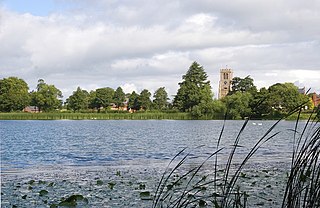
Sir David Hanmer, KS, SL (c.1332–1387) was a fourteenth century Anglo-Welsh Justice of the King's Bench from Hanmer, Wales, best known as Owain Glyndŵr's father-in-law and the father of Glyndŵr's chief supporters.

Welsh nationalism emphasises and celebrates the distinctiveness of Welsh culture and Wales as a nation or country. Welsh nationalism may also include calls for further autonomy or self-determination, which includes Welsh devolution, meaning increased powers for the Senedd, or full Welsh independence.
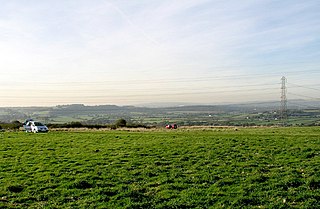
The Battle of Stalling Down, also known as the Battle of Bryn Owain, is reputed to have taken place between late autumn or early winter of 1403 or 1405 between a Welsh army under Owain Glyndŵr and an English army under King Henry IV of England. It was part of the Welsh Revolt of 1400–1415.

Owain Lawgoch, full name Owain ap Thomas ap Rhodri, was a Welsh soldier who served in Lombardy, France, Alsace, and Switzerland. He led a Free Company fighting for the French against the English in the Hundred Years' War. As a politically active descendant of Llywelyn the Great in the male line, he was a claimant to the title of Prince of Gwynedd and of Wales.
Alys ferch Owain Glyndŵr was one of the daughters of Margaret Hanmer and Owain Glyndŵr, the disinherited prince of the old Welsh royal house of Powys Fadog, who led a major revolt in Wales between 1400 and ca. 1416 against King Henry IV of England.

Wales in the late Middle Ages spanned the years 1282–1542, beginning with conquest and ending in union. Those years covered the period involving the closure of Welsh medieval royal houses during the late 13th century, and Wales' final ruler of the House of Aberffraw, the Welsh Prince Llywelyn II, also the era of the House of Plantagenet from England, specifically the male line descendants of Geoffrey Plantagenet, Count of Anjou as an ancestor of one of the Angevin kings of England who would go on to form the House of Tudor from England and Wales.

Siôn Cent, was a Welsh language poet, and is an important figure in Medieval Welsh literature.

King Arthur's messianic return is a mythological motif in the legend of King Arthur, which claims that he will one day return in the role of a messiah to save his people. It is an example of the king asleep in mountain motif. King Arthur was a legendary 6th-century British king. Few historical records of Arthur remain, and there are doubts that he ever existed, but he achieved a mythological status by High Middle Ages that gave rise to a growing literature about his life and deeds.

The Glyndŵr rebellion was a Welsh rebellion led by Owain Glyndŵr against the Kingdom of England during the Late Middle Ages. During the rebellion's height between 1403 and 1406, Owain exercised control over the majority of Wales after capturing several of the most powerful English castles in the country, and formed a parliament at Machynlleth. The revolt was the last major manifestation of Welsh independence before the annexation of Wales into England in 1543.
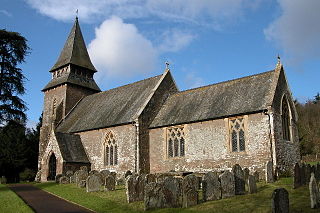
Kentchurch is a small village and civil parish in Herefordshire, England. It is located some 13 miles (21 km) south-west of Hereford and 13 miles (21 km) north-east of Abergavenny, beside the River Monnow and adjoining the boundary between England and Wales. The village name probably derives from an original dedication of the church to a 5th-century nun, Cein, or her sister Ceingar, who were daughters of Brychan, king of Brycheiniog.

Owain Glyndŵr Day is held annually on 16 September in Wales, as a celebration of Owain Glyndŵr, the last native Prince of Wales and founder of the first Welsh parliament.

Hywel Sele was a Welsh nobleman. A cousin of Owain Glyndŵr, Prince of Wales, he was a friend of Henry IV of England and opposed his cousin's 1400–1415 uprising. Sele was captured by Glyndŵr but is said to have accepted an invitation to hunt with his cousin on the Nannau Estate. Sele attempted to kill Glyndŵr but failed and was himself killed, his body being hidden within the hollow of an oak tree. The oak is subsequently said to have been haunted and was named Derwen Ceubren yr Ellyl or Ceubren yr Ellyll.
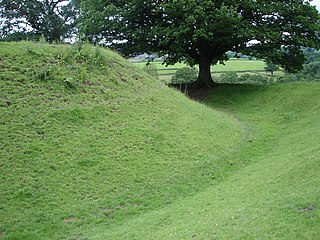
"Owain Glyndŵr's Court", also known as "Sycharth" or "The Court of Owain Glyndŵr at Sycharth", is a cywydd by the Welsh bard Iolo Goch. It describes and celebrates the hall and household of his patron, the nobleman Owain Glyndŵr, at Sycharth in Powys. It cannot be dated exactly, but was probably written about 1390, before Glyndŵr's revolt against the English crown. It survives in as many as 24 manuscripts.

There are multiple buildings and sites associated with Owain Glyndwr in Wales.
References
- 1 2 3 Seal, Graham (2001). Encyclopedia of Folk Heroes. ABC-CLIO. p. 121. ISBN 1-57607-216-9.
- ↑ Greene, William Henry (1974). Jack O' Kent and the Devil: Stories of a Welsh Border Hero Told in Verse. Chepstow Society. ISBN 0-900278-21-8.
- ↑ Simpson, Jacqueline; Roud, Steve (2000). A Dictionary Of English Folklore. Oxford University Press. ISBN 978-0-19-210019-1.
- ↑ Gibbon, Alex (2007). The mystery of Jack of Kent & the fate of Owain Glyndŵr. Stroud: Sutton. ISBN 978-0-7509-3320-9.
- 1 2 Westwood, Jennifer (1985). Albion: A Guide to Legendary Britain. Granada. pp. 278–280. ISBN 0-246-11789-3.
- ↑ Hando, F., (1944), The Pleasant Land of Gwent, Newport: R. H. Johns